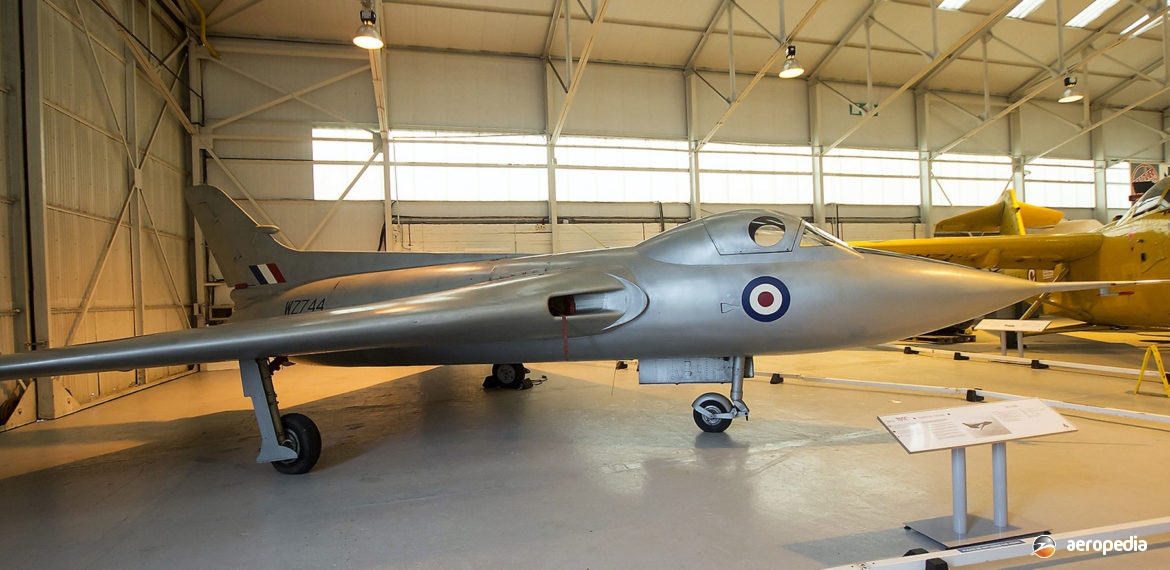Photograph:
Avro 707C WZ744 at Cosford, United Kingdom in July 2012 (Steve Veigel)
Country of origin:
United Kingdom
Description:
Two-seat research aircraft
Power Plant:
One 3,600 lbst Rolls Royce Derwent 8 single-stage axial flow turbojet
Specifications:
- Wingspan: 10.41 m (34 ft 2 in)
- Length: 12.9 m (42 ft 4 in)
- Height: 3.53 m (11 ft 7 in)
- Wing area: 39.01 m² (420 sq ft)
- Wheel track: 4.66 m (15 ft 3 in)
- Wheelbase: 4.15 m (13 ft 7 in)
- Max speed: 747 km/h (464 mph)
- Empty weight: 3,571 kg (7,873 lb)
- Loaded weight: 4,457 kg (9,826 lb)
History:
The Avro 707 series was designed in the United Kingdom solely for research work into the delta-wing configuration. Five aircraft of the type were built, each slightly different from the others. The first example, the Type 707 (VX784), was a single-seater and flew for the first time on 4 September 1949, this aircraft eventually being lost in a crash.
This was followed on 6 September 1950 by the 707B (VX790), which was painted blue and was scrapped at the end of its test life.
This was followed by the 707A, two examples of which were built (WD280 and WZ736), the former originally painted salmon pink, then red; and the latter painted orange. WD280 made its first flight on 14 June 1951 and WZ736 on 20 February 1953. Both were single-seaters, but the 707A had a modified wing section and root intakes to enable higher speeds to be achieved.
Power plant installed in all aircraft was the Rolls Royce Derwent 8 axial-flow turbojet.
Later a two-seat model, the 707C (WZ744), was built and entered the test programme. The 707C was flown for the first time on 1 July 1953. After testing at Farnborough in Hampshire with electrically signalled hydraulic power controls it was retired.
One model 707A survives in Australia. This aircraft WD280 was overhauled by A V Roe, ferried from Manchester to Renfrew Airport, Scotland and conveyed to the King George V Docks in Glasgow, Scotland by road. Painted red overall at the time, it was then loaded on board the aircraft carrier ‘HMAS Melbourne’. The ship sailed on 12 March that year. The aircraft was off-loaded at Garden Island in Sydney, NSW, transferred to ‘HMAS Sydney’ and taken to Melbourne, VIC. On 29 May 1956 it was unloaded and taken to Laverton, VIC where the first flight in Australia was made on 13 July 1956.
The 707A was shipped to Australia for investigations into airflow over delta wings at low speed by the Aeronautical Research Laboratories of the Department of Supply and operated from Avalon, VIC. It was handed over to the RAAF on 3 March 1956, having completed a total flight time of 283 hrs 10 mins. It was then involved in a research programme directed and co-ordinated by the Aeronautical Research Laboratories. Flight operations of the aircraft were the responsibility of the RAAF’s Aircraft Research and Development Unit (ARDU).
First public flight was on 24 July 1956. In the period 13 July 1956 to 3 April 1957 some 51 flights were conducted, involving some 30 hours. In May 1957 the aircraft buffet boundaries were measured up to and beyond Mach 0.80. Although it has not been possible to obtain any performance details, it is known on take-off the nosewheel could be raised at 139 km/h (86 mph / 75 knots), and it could fly off at 204 km/h (127 mph / 110 knots). Air brakes were provided for speed reduction and approach speed recorded at 241 km/h (150 mph / 130 knots), final approach speed being 213 km/h (132 mph / 115 knots).
Towards the end of 1957 a preliminary investigation of the fatigue strength of the aircraft was conducted. In 1958 Wing Commander F A Cousins, who had been the Chief Test Pilot at ARDU, handed over flying of the aircraft to Flt Lt Randal R Green and a series of tests was undertaken to evaluate low speed handling.
In 1960 the test programme envisaged the modification of the wing to enable the installation of a system of boundary layer control using suction. In 1961 and 1962 longitudinal stability tests were conducted to determine the dynamic stability characteristics at low speed. Last flight of the aircraft was in 1963 and during its seven years of test flying in Australia it flew 203 hrs 30 mins, each flight being of 20 to 30 minutes duration. In May 1964 the aircraft was placed on display during an open day at RAAF Laverton.
Eventually WD280 became surplus to requirements and was sold by auction, the new owner, Geoffrey Mallett of Williamstown, VIC, having to agree that the aircraft would not be scrapped. It subsequently spent many years in the owner’s yard of his home until, in 1999, it was obtained by the RAAF Museum at Point Cook, VIC where it is now on display.
Two other examples of the series survive. WZ736, a 707A, is held in the collection of the Greater Manchester Museum of Science and Industry; and WZ744, a 707C, is held and displayed by the Cosford Aerospace Museum in Shropshire, both in the United Kingdom.

